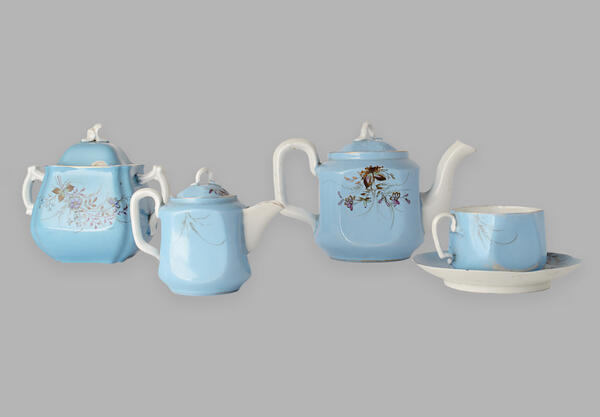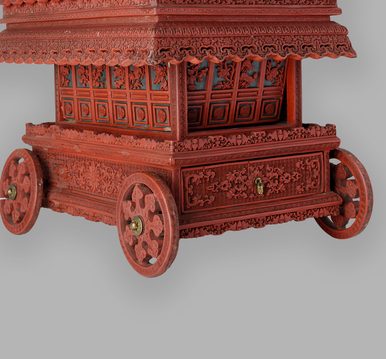The Russian porcelain industry experienced rapid growth in the 19th century. This growth was promoted by high duties on imported porcelain and the abundance of raw materials. The 19thcentury can be called the “golden age of Russian porcelain” when valuable artworks were created.
The late-19th-century porcelain products are characterized by complicated forms and abundant gilding. The porcelain collection, which was presented to the Kyakhta Museum by the State Hermitage Museum, features products of the Imperial Porcelain Factory. They are distinguished by their beauty and elegance.
The blue tea set with a floral pattern of branches and small flowers includes a teapot, a sugar bowl, a milk pot, a cup, and a saucer. The teapot and the sugar bowl are square with rounded corners. The sugar bowl has rounded handles on both sides. Three items feature lids with the same decorative pattern. The milk pot has a long spout, a curved handle, and a flat lid. The hexagonal cup features a curved handle, while the saucer has a wavy rim.
At the bottom, all items are stamped with a brand of Matvey Kuznetsov. The entrepreneur registered his “Partnership for the Production of Porcelain and Faience Products” on September 29, 1887. The company grew to include seven Russian factories producing faience and porcelain tableware in Riga, Dulyovo, Novgorod, and other cities. The partnership’s headquarters was located on Myasnitskaya Street in Moscow.
The tea set from the collection of the Kyakhta Museum was produced at the Dmitrov Factory at the end of the 19th century. The Dmitrov Factory was the first private enterprise to produce porcelain in Russia. Back in 1766, it was founded by Francis Gardner, an entrepreneur of English origin.
The factory produced
excellent porcelain, and the founder was granted an audience by Empress
Catherine II. However, by the end of the 19th century, the factory
was no longer as successful as before and soon was bought out by Matvey
Kuznetsov. As a far-sighted businessman, he realized that Gardner porcelain was
a household name. Willing to retain loyal customers, Kuznetsov decided to keep
the famous Gardner brand on the new products. The factory produced dinnerware
sets, chandeliers, lamps, vases, and animal figurines. After the Revolution of
1917, it was renamed the Dmitrov Porcelain Factory and nationalized.





